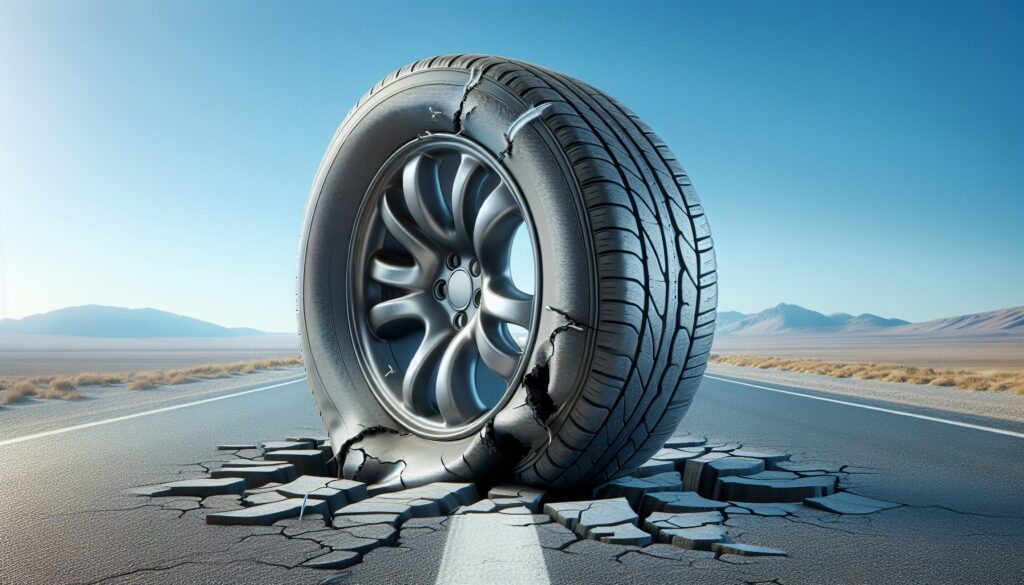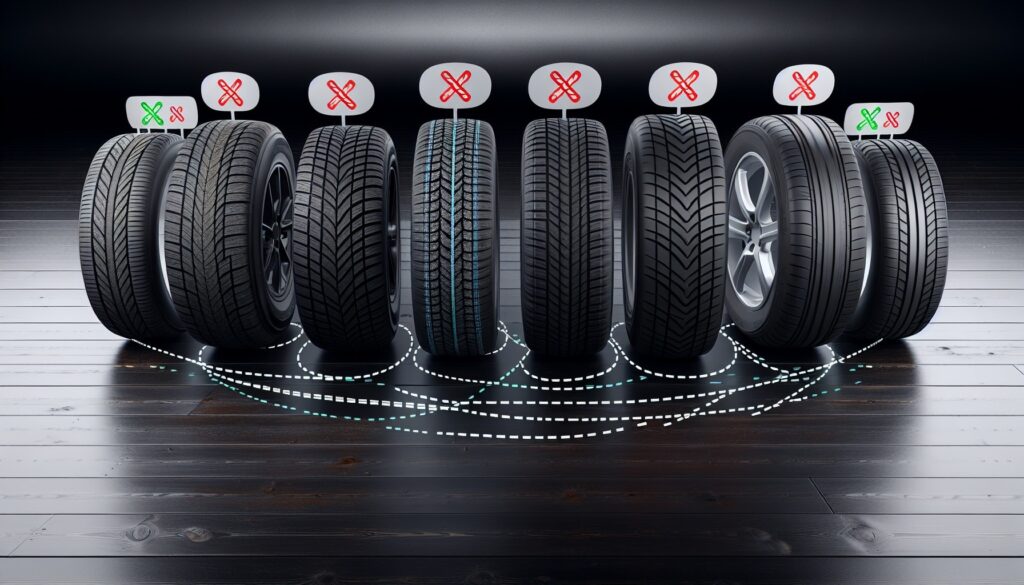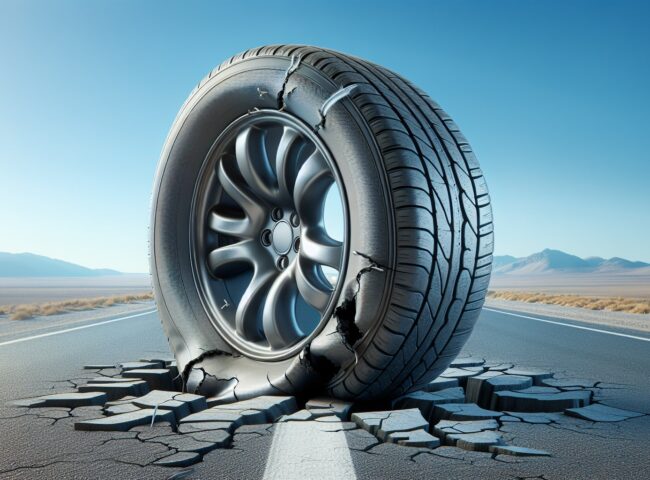Tire and wheel coverage, or “what is tire and wheel coverage,” is a targeted insurance plan that protects your vehicle’s tires and wheels from damage resulting from road hazards like potholes and debris. This specialized cover is essential for those looking to shield themselves from the unexpected costs not typically covered by standard auto insurance policies. The following guide will explain the ins and outs of what is tire and wheel coverage, the types of damage included, and offer insights on selecting the ideal protection for your driving needs.
Key Takeaways
- Tire and Wheel Protection Plans cover repair or replacement costs due to damage from road hazards that standard auto insurance policies might exclude, including flats from nails, structural damage from potholes, and issues detected by tire pressure monitoring systems.
- These protection plans offer numerous features such as no deductible, unlimited claims, substantial maximum lifetime benefits of up to $5,000, and often include roadside assistance benefits like towing and emergency fuel delivery.
- While these plans cover damage from common road hazards such as potholes and road debris, they exclude incidents related to accidents, theft, vandalism, misuse, negligence, abnormal wear and tear, and certain types of competitive driving activities.
Defining Tire and Wheel Coverage

Envision Tire and Wheel Protection Plans as armor safeguarding your vehicle’s tires and wheels from the relentless onslaught of the road. These plans offer coverage for repair costs that standard auto insurance policies may not take into account. The purpose? To protect you, the car owner, from unforeseen expenses due to tire and wheel damage caused by road hazards.
In the face of unforeseen events such as a flat tire caused by a stray nail on the road, a tire damaged structurally by a vicious pothole, or an issue detected by your tire pressure monitoring system, a wheel protection service contract comes to the rescue. It provides peace of mind that your wallet won’t take a hit every time your car’s tires do.
Purpose of Tire and Wheel Protection
For the best Tire and Wheel Protection Plans reviews augment standard insurance coverage by cushioning against the financial impact of tire and wheel damage. Imagine driving along a poorly maintained country road, your steel wheels taking a beating from the uneven surface. A standard tire could easily get damaged, and without any tire and wheel protection, you would need to cover the repair or replacement costs out of your own pocket.
Wheel protection tire coverage, though, eliminates such concerns. These plans have your back, covering the repair or replacement costs for your vehicle’s tires and wheels. So, whether it’s a structurally damaged tire or a flat tire due to a covered road hazard, you can drive with peace of mind knowing that your plan has you covered.
Types of Damage Covered
Protection plans aim to cover prevalent damage types, excluding normal wear structural damage, such as:
- damage resulting from road debris
- damage from potholes
- blowouts
- manufacturer defects
Imagine driving down a seemingly harmless street when suddenly, a wild pothole appears, causing substantial damage to your tire. With tire and wheel protection, you’re covered!
The coverage applies to the original set of tires on the vehicle at the time of purchase and any new replacement tires, ensuring protection against common incidents. This means that even if you’ve replaced a damaged tire with a new one, the new tire is also covered under your plan. So, whether you’re dealing with a single tire coverage issue or multiple tire replacements, your tire and wheel protection plan has got you covered.
Key Features of Tire and Wheel Protection Plans

What distinguishes Tire and Wheel Protection Plans from conventional insurance policies? These plans come with a plethora of features such as no deductible, no limit on the number of claims, and coverage availability for vehicles with higher mileages. This means that you can make as many claims as needed without worrying about hitting a limit or having to pay a deductible each time.
Moreover, these plans typically feature a maximum lifetime benefit, with some offering coverage up to $5,000, providing substantial financial support for tire and wheel repairs or replacements. The cost for these insurance plans can vary, but annual charges generally range between $60 and $90, depending on factors like geographical location, the specific vehicle, and the desired extent of coverage.
Repair and Replacement Services

Tire and wheel protection plans’ repair and replacement services handle the costs associated with fixing or replacing tires damaged by diverse road hazards. Picture this: you’re driving down a narrow country road when suddenly, a rogue rock hits your wheel, causing it to lose balance. Under normal circumstances, this would mean a hefty bill for you. But with a wheel protection service contract, you’re covered!
Under these plans, wheels qualify for replacement if they can’t be balanced, maintain air pressure, or if road hazard damage compromises their structural integrity. Moreover, these plans typically establish a maximum lifetime benefit, often around $5,000, for the repair or replacement of covered damages, including minor wheel repair and up to eight individual wheel repairs, offering substantial financial support to cover replacement costs when you need it the most.
Cosmetic Wheel Repairs

While standard tire and wheel protection plans do not account for cosmetic damage, premium options covering minor cosmetic damages such as scrapes and scratches are available. These premium plans, such as the Tire and Wheel Protection Plus plans, offer coverage for cosmetic wheel repair to alloy or steel factory wheels.
So, if you’re someone who pays attention to the smallest details and wants to keep your wheels looking pristine, a premium plan might be right up your alley. After all, it’s not just about keeping your vehicle running smoothly, but also maintaining its aesthetic appeal.
Roadside Assistance Benefits
Many tire and wheel protection plans include roadside assistance benefits, offering support during instances of vehicle trouble on the road. Some of the benefits of roadside assistance include:
- Help with flat tire changes
- Jump-starting a dead battery
- Emergency fuel delivery
- Towing services
- Lockout assistance
Imagine being stranded on a deserted road with a flat tire. Sounds terrifying, right? However, with roadside assistance benefits, help is just a call away.
These benefits frequently cover services like towing, battery service, and locksmith service for situations where the tire and wheel are damaged or the vehicle is immobilized. Moreover, reimbursement for service towing expenses is typically available up to a certain amount for each occurrence.
When evaluating tire and wheel protection plans, considering additional benefits such as trip interruption services and alternate transportation can enhance the overall value of the plan.
Understanding Covered and Non-Covered Road Hazards
Understanding the difference between covered and non-covered road hazards is vital when investing in tire and wheel protection plans. These plans offer coverage for damages resulting from encounters with road hazards such as:
- potholes
- cracks
- breaks in the road surface
- various types of debris that can compromise tire and wheel integrity.
It’s like having an invisible shield that protects your tires and wheels from all the rough and tumble of the road. However, while these plans cover a lot, they don’t cover everything. Some hazards may not be covered, indicating the presence of plan exclusions that policyholders need to be aware of.
Common Covered Hazards
Hazards on the road that lead to flat tires or wheel damage due to conditions like potholes, cracks, and breaks are usually covered. It’s like your tires have a personal bodyguard, ready to step in and take the hit whenever a road hazard tries to cause damage.
Damages from road debris, potholes, and blowouts are typically covered under standard tire and wheel protection plans. Some plans even offer full Road Hazard Protection, which covers a broader range of road-induced damages. Additionally, certain protection plans may include coverage for manufacturer defects alongside road hazard damage, making them an even more comprehensive solution to protect your tires and wheels.
Exclusions and Limitations
Despite the extensive tires coverage, tire and wheel protection plans offer, they do have certain limitations and exclusions. Failures caused by accidents, theft, vandalism, misuse, negligence, or abnormal wear and tear are generally not covered. This means that if your tires are damaged due to racing or competitive driving activities, or normal wear and tear, you might need to bear the repair or replacement costs yourself.
Damage occurring within designated construction zones and due to objects or conditions in those zones, such as repaving or metal plates temporarily covering holes, are typically not covered under these plans. Coverage is usually limited to the original set of tires on the vehicle at the time of purchase and new replacement tires, excluding tires with less than 3/32” of tread depth, dry rot, and racing tires. Therefore, it’s important to understand these exclusions and limitations to set appropriate expectations for your protection plan.
Choosing the Right Tire and Wheel Protection Plan
The selection of the appropriate tire and wheel protection plan requires an assessment of local road conditions, the probability of encountering road hazards, and contemplation of factors like coverage level, cost, and provider reputation. It’s like tailoring your own suit – you want it to fit perfectly, matching your specific needs and preferences.
Tire and wheel protection plans typically set limits based on a specific duration of time, maximum mileage, or a cap on repair costs. Therefore, when selecting a plan, it’s crucial to consider the relevance of the plan’s time, mileage, and cost limitations to your regular driving patterns and vehicle usage.
Factors to Consider
While contemplating various plans, several factors demand your attention. The coverage level is a key factor. Some plans may include reimbursement for alternate transportation if the vehicle cannot be repaired within the same day due to a covered tire or wheel repair. If you rely heavily on your vehicle for daily commute, this could be a beneficial feature for you.
The cost of a tire and wheel protection plan is another critical factor to consider, as it impacts the overall value and affordability of the plan for the vehicle owner. Additionally, the reputation of the provider offering the protection is essential to ensure reliable and trustworthy service when a claim is made.
Comparing Plans
As you compare tire and wheel protection plans, examining the policy’s coverage limits and exclusions for alignment with your specific needs is imperative. It’s like shopping for a new outfit – you want it to fit your style, body type, and budget perfectly.
Assessing whether there’s a deductible for claims in these plans is also important to understand potential out-of-pocket expenses. After all, the goal is to minimize your financial burden in case of tire or wheel damage, not add to it.
Purchasing Tire and Wheel Protection

Whether new or pre-owned, tire and wheel protection is usually acquired at the time of vehicle sale. Some companies offer the opportunity to purchase this protection after the initial sale, although early purchase is advisable. It’s like buying an umbrella before the rain – you may not need it right away, but it’s good to have it at hand when the rain starts pouring.
Tire and wheel protection plans are offered by automakers, car dealerships, and third-party providers alike. Each option may come with different pricing, terms, and benefits. Third-party providers may offer more competitive pricing or more flexible terms compared to dealership options, while dealerships may offer the convenience of integration with the vehicle purchase process.
Automakers may provide plans tailored specifically to their vehicles, with potential benefits such as using official parts and service locations.
Timing of Purchase
Acquiring tire and wheel protection at the moment of vehicle purchase or lease guarantees immediate protection, ensuring coverage from the outset. Plus, dealerships often offer special deals on these plans when bundled with the vehicle purchase, potentially saving buyers money.
To be eligible for tire and wheel coverage, the purchase often needs to coincide with the start of the vehicle’s lease or ownership. When purchasing coverage, it typically begins immediately upon purchase if it aligns with the acquisition of the vehicle. On the other hand, if the protection is not purchased at the initial point of sale, altering or obtaining a new plan may be more complex and could lead to periods without coverage.
Provider Options
A variety of providers offer tire and wheel protection plans. These include:
- Dealerships
- Roadside-assistance companies like AAA
- Automotive insurance companies
- Local tire shops
It’s like having a buffet of options to choose from – each with its unique offerings and advantages.
Choosing a provider is not a one-size-fits-all decision. Different providers may offer different coverage levels, pricing, and benefits. It’s crucial to research and compare the offerings of different providers to find a plan that best suits your specific needs and budget.
Summary
In conclusion, tire and wheel protection plans offer a safety net for your vehicle’s tires and wheels, providing coverage for repair or replacement costs due to damages caused by road hazards. These plans come packed with features such as no deductible, no limit on the number of claims, and coverage for vehicles with higher mileages. They cover common types of damage from road debris, potholes, blowouts, and manufacturer defects.
However, not all road hazards are covered, and there are certain exclusions and limitations to be aware of. When selecting a plan, consider factors such as coverage level, cost, provider reputation, and the likelihood of encountering road hazards. Remember, the purpose of these plans is to offer financial protection against unexpected tire and wheel damage, allowing you to hit the road with peace of mind.
Frequently Asked Questions
Are tires and rims covered under warranty?
Tires may have treadwear/mileage warranties, but they typically do not cover original equipment on new vehicles. Replacement tires covered by a warranty have the cost factored into their price.
How much is tire warranty?
A tire warranty typically costs 10 to 12 percent of the total cost of the tires.
What is a tire and wheel protection plan?
A tire and wheel protection plan is an insurance product that provides coverage for repair costs of tires and wheels not typically covered by standard auto insurance policies, protecting car owners from unexpected expenses due to road hazard damage.
What kind of damage is covered under these plans?
The plans cover common types of damage such as road debris, potholes, blowouts, and damage due to manufacturer defects.
Where can I purchase a tire and wheel protection plan?
You can purchase a tire and wheel protection plan from various providers such as dealerships, roadside-assistance companies like AAA, automotive insurance companies, and local tire shops. Consider researching the options to find the best plan for your needs.

